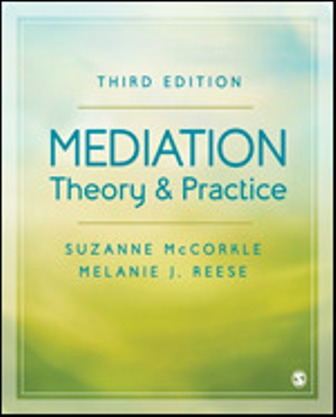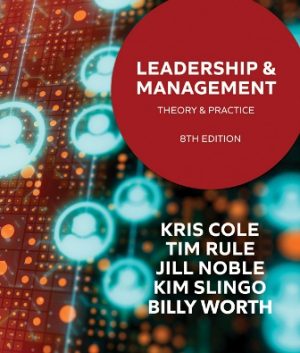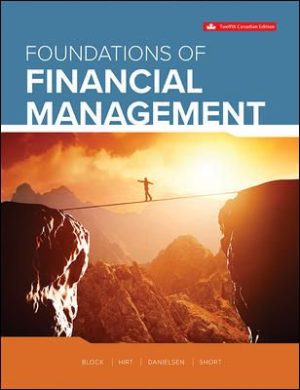Test Bank for Mediation Theory and Practice 3/E McCorkle
Test Bank for Mediation Theory and Practice, 3rd Edition, Suzanne McCorkle, Melanie J. Reese, ISBN: 9781506363547
Table of Contents
Chapter 1: Introduction to Mediation Why Mediation?
Benefits for the Disputants
Benefits for the Mediator
How Do People Find Their Way to Mediation?
Family Mediation
Community Mediation
Victim–Offender Mediation
School-Based Peer Mediation
Organizational Mediation
Government and Court-Annexed Mediation
Power, Rights, and Interests
Resolving through Power
Resolving through Rights
Resolving through Interests
The Dispute Resolution Continuum
Litigation
Arbitration
Med-Arb
Mediation
Informal Conflict Management
A Disclaimer about Mediation Training
Summary
Chapter Resources
Portfolio Assignment 1.1: Starting Your Mediator Portfolio
Portfolio Assignment 1.2: Personal Reflections
Chapter 2: The Basic Components of Mediation
Philosophical Assumptions
Facilitative Approach
Transformative Approach
Evaluative Approach
Comparing the Three Approaches
Functional Models
Integrating Philosophies
Variables That Make a Difference in Mediation Models
Premediation or No Premediation
Allow Uninterrupted Disputant First Statements or Control When and How Long Each Person Speaks
Allow, Require, or Forbid Private Meetings between the Mediator and the Parties
Require an Agenda before Negotiating, Negotiate as You Go, or Slide Back and Forth between Issue Identification and Negotiation
Consider the Parts of the Mediation as Functional Phases or as Chronological Steps
Focus on the Problem, Focus on the Emotions, or Balance Problems and Emotions
Prescribe Automatic First Moves within Phases or Allow Mediator Choice
Allowing or Prohibiting Parties to Speak to Each Other
Writing and Signing or Not Signing Agreements
Phases in the Balanced Mediation Model
Premediation
Mediation Session
Postmediation
Does Culture Matter in Mediation?
Summary
Chapter Resources
Portfolio Assignment 2.1: Personal Reflections on Mediation Philosophy
Portfolio Assignment 2.2: Personal Reflections on Culture
Chapter 3: Essential Skills for Mediators
An Overview of Mediator Skills
Trusting and Controlling the Process
Trusting the Process
Controlling the Process
Listening: A Bedrock Skill for Mediators
Types of Listening
Variables That Affect Listening
Skills for Listening to Content, Emotion, and Relationship
Reframing Messages
Listening to Nonverbal Communication
Clarifying and Asking Questions
Open versus Closed Questions
Genuinely Curious Questions
Honoring Silence
Listening Interculturally
Ethical Issues and Listening
Summary
Chapter Resources
Portfolio Assignment 3.1: Emotional Paraphrases
Portfolio Assignment 3.2: The Open-Ended Question
Chapter 4: Premediation Activities
Contacting Disputants
Goals to Accomplish During Intake
Education Role
Information-Gathering Role
Assessment Role
Setting the Stage
Time and Timing
Place
Environment
Summary
Chapter Resources
Portfolio Assignment 4.1: The Referral Sourcebook
Portfolio Assignment 4.2: Intake and Agreement to Mediate Forms
Chapter 5: Ethical Considerations and Tactical Preparations
Mediator Roles
Ethical Considerations in the Mediation Community
Ethical Considerations for Mediators
Neutrality and Impartiality
Reality Testing
Competence
Dual-Role Relationships
Truthfulness
Informed Choice
Conclusions about Mediator Ethics
Disputant Roles
Analyzing Stakeholders
The Mediation Plan
Common Causes of Conflict
Conflict Causes and Mediator Moves
Cultural Awareness
Summary
Chapter Resources
Portfolio Assignment 5.1: Ethical Codes of Conduct
Portfolio Assignment 5.2: Mediator Supplies
Portfolio Assignment 5.3: Personal Reflections That Deepen Cultural Awareness
Chapter 6: The Mediator’s Opening Statement
Managing Arrivals and Seating
Opening Statement Functions
Opening Statement Styles
Monologue Style
Interactive Style
Opening Statement Dynamics
Length
Order
Key Components of the Opening Statement
Welcoming
Introductions
Building Credibility
Establishing Stakeholders
Explaining the Nature and Scope of Mediation
Explaining the Mediator’s Role
Explaining the Caucus
Explaining Impartiality and Neutrality
Giving a Confidentiality Statement
Disclosing Notetaking Purposes
Establishing Ground Rules
Discuss Facilities
Discovering Time Constraints
Explaining the Role of Outside Experts
Securing the Commitment to Begin
Transitioning to Storytelling
Building Credibility and Rapport
The Relationship between Opening Statements and Mediator Control
Notetaking for Mediators
Summary
Chapter Resources
Portfolio Assignment 6.1: Creating Your Personal Opening Statement
Portfolio Assignment 6.2: Creating Your Personal Notetaking Form
Chapter 7: Storytelling and Issue Identification
Theories of Storytelling
Symbolic Interaction
Attribution Theory
Emotional Intelligence
Functions of Storytelling
The Individual
The Mediator
Mediator Strategies in Storytelling
One Storyteller at a Time
Co-Constructing Stories
General Inquiry Questions
Whole Picture Questions
The Naïve Detective
Specific Inquiry Questions
Establishing Agreed-Upon “Facts”
Weighing the Importance of Disagreements
Perspective Taking
Humor
Recognizing Turning Points
Overcoming Common Pitfalls during Storytelling
Pitfall 1: Unchecked Power Differences
Pitfall 2: Allowing Blaming and Attacking
Pitfall 3: Acting on Overstatements or Generalizations
Pitfall 4: Taking Sides
Pitfall 5: Permitting Interrupting and Bickering
Pitfall 6: Mismanaging Emotional Outbursts
Pitfall 7: Letting One Party Monopolize Time or Control the Process
Pitfall 8: Being Overwhelmed with Evidence
Conflict Causes and Mediator Moves
Summary
Chapter Resources
Portfolio Assignment 7.1: The Vision Quest
Portfolio Assignment 7.2: Reframes
Portfolio Assignment 7.3: Personal Reflection
Chapter 8: Setting the Agenda for Negotiation
Mediator’s Notes Are the Building Blocks of the Agenda
When to Shift to the Agenda Step
Components of the Agenda
The Commonality Statement
The Agenda List
Sequencing the Agenda List
Who Decides the Order of the Agenda?
Considerations When Choosing the Agenda Sequence
Adding an Issue for Continuing Relationships
Alternate Methods of Creating the Agenda
Framing the Agenda Neutrally and Mutually
Summary
Chapter Resources
Portfolio Assignment 8.1: Methods of Ordering the Agenda
Portfolio Assignment 8.2: Transitioning to the Agenda
Chapter 9: Problem Solving and Negotiation
The Two Worlds of Negotiation
Directiveness vs. Intrusiveness
Mediator Techniques to Foster Disputant Problem Solving
Starting the Negotiation
Techniques for Cooperative Negotiation
Techniques for Traditional Negotiation
Using the Caucus to Respond to Common Problems
Not Bargaining in Good Faith
Hidden Agendas
Reality Check
Lying or Withholding Information
Shuttle
Breaking Deadlocks
Analyze the Impasse
Techniques to Break through Impasse
Face-Saving
Ending the Negotiation Phase
Mediator Ethics and the Negotiation Phase
Summary
Chapter Resources
Portfolio Assignment 9.1: Questions to Start Negotiation
Portfolio Assignment 9.2: Going into Caucus
Portfolio Assignment 9.3: Personal Reflections on Face
Chapter 10: Settlement and Closure
Why Write Agreements?
Is the Agreement Legally Binding or Legally Nonbinding?
A Format for Writing Mediation Agreements
Choosing the Phrasing of the Agreement
Agreements Use Direct Language
Agreements Are Clear
Agreements Generally Are Positive
Agreements Are Impartial
Agreements Are Concrete
Agreements Arise from the Parties’ Words
Creating Durable Agreements
Contingency Agreements
Future Communication Clauses
Reality Testing
Partial Agreements
Final Reading and Signing
Closing a Nonagreement Mediation
Debriefing the Session
Summary
Chapter Resources
Portfolio Assignment 10.1: Memorandum of Agreement Form
Chapter 11: The World of the Mediator
Variations on Basic Mediation
Co-Mediation
Panels
Extended Premediation
Mediation and the Internet
Mediation as a Profession
Employment Opportunities for Mediators
Cross-Training and Life Skills
Standards of Professional Conduct
Professional Mediator Competencies
Mediation Skills in Everyday Life
Summary
Chapter Resources
Portfolio Assignment 11.1: My Current Skill Level
Appendix A: Practice Cases Appendix B: Mediator Skills Checklist Glossary References Index
For instructors
Please select a format




